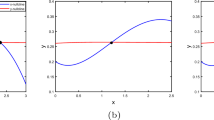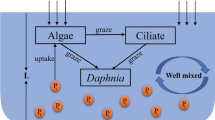Abstract
The general mathematical theory of the gradostat is presented for two competitors. The gradostat provides a mechanism for studying competition along a nutrient gradient. In the two vessel case, the results are complete and the conditions are testable. In then-vessel case, the relevant conditions are stated in terms of the stability modulii of certain matrices and are testable for any specific case.
Similar content being viewed by others
References
Berman A, Plemmons RJ (1979) Nonnegative matrices in the mathematical sciences. Academic Press, New York.
Butler G, Freedman HI, Waltman P (1986) Uniformly persistent systems. Proc Am Math Soc 96:425–430
Butler G, Waltman P (1986) Persistence in dynamical systems. J Differential Equations 63: 255–263
Chang SW, Baltzis BC (1989) Impossibility of coexistence of three pure and simple competitors in configurations of three interconnected chemostats. Biotech Bioeng 33:460–470
Frederickson AG, Stephanopoulous G (1979) Effect of spatial inhomogeneities on the coexistence of competing microbial populations. Biotech Bioeng XXI:1491–1498
Frederickson AG, Stephanopoulous G (1981) Microbial competition. Science 213:972–979
Hirsch M (1985) Systems of differential equations which are competitive or cooperative. II: Convergence almost everywhere. Siam J Appl Math 16:423–439
Jäger W, So JW-H, Tang B, Waltman P (1987) Competition in the gradostat. J Math Biol 25: 23–42
Jäger W, Smith HL, Tang B (1990) Some aspects of competitive coexistence and persistence in the gradostat to appear. Proc International Conf on Differential Equations and Applications to Biology and Population Dynamics, Claremont, CA
Jannasch HW, Mateles RT (1974) Experimental bacterial ecology studied in continuous culture. Adv Microbiol Physiol 11:165–212
Kung C-M, Baltzis BC (1987) Operating parameters' effects on the outcome of pure and simple competition between two populations in configurations of two interconnected chemostats. Biotech Bioeng 30:1006–1018
Lovitt RW, Wimpenny JWT (1981) The gradostat: A bidirectional compound chemostat and its applications in microbiological research. J Gen Microbiol 127:261–268
Monod J (1949) The growth of bacterial cultures. Ann Rev Microbiol 1:371–394
Smith HL (1990) Microbial growth in periodic gradostat. Rocky Mountain Math J 20:1173–1194
Smith HL (1988) Systems of ordinary differential equations which generate and order preserving flow: A survey of results. Siam Rev 30:87–113
Smith HL, Tang B (1989) Competition in the gradostat: The role of the communication rat. J Math Biol 27:139–165
Smith HL, Tang B, Waltman P (1991) Competition in ann-vessel gradostat. Siam J Appl Math 51 (in press)
Tang B (1986) Mathematical investigations of growth of microorganisms in the gradostat. J Math Biol 23:319–339
Veldkamp H (1977) Ecological studies with the chemostat. Adv Microbial Ecol 1:59–95
Waltman P, Hubbell SP, Hsu SP (1980) Theoretical and experiemental investigations of microbial competition in continuous culture. In: Burton T (ed) Modeling and differential equations in biology. Marcel Dekker, New York
Wimpenny JWT, Lovitt RW (1984) The investigation and analysis of heterogeneous environments using the gradostat. In: Granger JM, Lynch JM (eds) Microbiological methods for environmental biotechnology. Academy Press, London
Author information
Authors and Affiliations
Rights and permissions
About this article
Cite this article
Smith, H.L., Waltman, P. The gradostat: A model of competition along a nutrient gradient. Microb Ecol 22, 207–226 (1991). https://doi.org/10.1007/BF02540224
Received:
Revised:
Issue Date:
DOI: https://doi.org/10.1007/BF02540224




